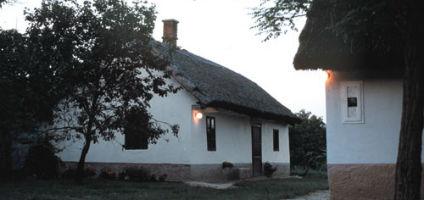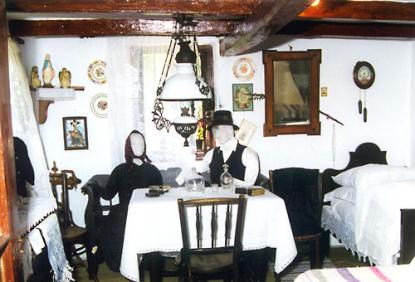2024. November 23. Saturday
Blaskovich Museum - Ethnographical House - Tápiószele
 |
Address: 2766, Tápiószele Ceglédi út 5.
Phone number: (53) 380-157
E-mail: blaskovichmuzeum@femuz.hu
|
Museum tickets, service costs:
|
Ticket for adults
|
100 HUF
|
|
|
Ticket for students
|
50 HUF
|
The furnishing of the cottar house built at the turn of the century provides an insight at the life of the small landholders and farmers of Tápiószele.

The house made with clay and straw mortar and thatched roof is made up of three rooms. The entrance leads to the kitchen where the furnace is opposite the door. An iron pot and an iron are on it. There are a water jug, a can and a pail in front of the stove. There are a table with chairs and a washing table in the kitchen. The walls have traditional metal and tile dishes and wallpapers on.
The stove of the cotter house was also used for baking and cooking besides heating the house. The stove also served as a place to sit and sleep on. The main furniture of this room is the made bed with a cover on it, laced pillows and a large duvet. The wooden couch is in front of the window facing the street, next to it a mirror and the 'blessing of the house' stand. The traditional drawer is also placed in the room, as well as the commode that had the 'treasures' of the family such as framed photos, cups and glasses, as well as a so-called 'patience glass' on. There sometimes also was a sawing machine or a spinning wheel in this room. The ornamenting objects of the room betrayed the religion and the social statues of the family.
The woman and man of the house sitting on the bench welcome the visitors. Next to the commode the cloths of an old woman and a young child from the 30-40's are displayed.
The chamber of the house held the equipment and tools of farming. Among the tools of the housewife, the visitors may see the tools of hemp procession, and equipment necessary for making butter, jelly and bread. The equipments of viniculture are in the small chamber.

The house made with clay and straw mortar and thatched roof is made up of three rooms. The entrance leads to the kitchen where the furnace is opposite the door. An iron pot and an iron are on it. There are a water jug, a can and a pail in front of the stove. There are a table with chairs and a washing table in the kitchen. The walls have traditional metal and tile dishes and wallpapers on.
The stove of the cotter house was also used for baking and cooking besides heating the house. The stove also served as a place to sit and sleep on. The main furniture of this room is the made bed with a cover on it, laced pillows and a large duvet. The wooden couch is in front of the window facing the street, next to it a mirror and the 'blessing of the house' stand. The traditional drawer is also placed in the room, as well as the commode that had the 'treasures' of the family such as framed photos, cups and glasses, as well as a so-called 'patience glass' on. There sometimes also was a sawing machine or a spinning wheel in this room. The ornamenting objects of the room betrayed the religion and the social statues of the family.
The woman and man of the house sitting on the bench welcome the visitors. Next to the commode the cloths of an old woman and a young child from the 30-40's are displayed.
The chamber of the house held the equipment and tools of farming. Among the tools of the housewife, the visitors may see the tools of hemp procession, and equipment necessary for making butter, jelly and bread. The equipments of viniculture are in the small chamber.
